
Coeur d'Alene is a city and the county seat of Kootenai County, Idaho, United States. It is the largest city in North Idaho and the principal city of the Coeur d'Alene Metropolitan Statistical Area. At the 2020 census the city's population was 54,628. Coeur d'Alene is a satellite city of Spokane, which is located about thirty miles (50 km) to the west in the state of Washington. The two cities are the key components of the Spokane–Coeur d'Alene Combined Statistical Area, of which Coeur d'Alene is the third-largest city. The city is situated on the north shore of the 25-mile (40 km) long Lake Coeur d'Alene and to the west of the Coeur d'Alene Mountains. Locally, Coeur d'Alene is known as the "Lake City," or simply called by its initials, "CDA."
Kirtland Kelsey Cutter was a 20th-century architect in the Pacific Northwest and California. He was born in East Rockport, Ohio, the great-grandson of Jared Potter Kirtland. He studied painting and illustration at the Art Students League of New York. At the age of 26 he moved to Spokane, Washington, and began working as a banker for his uncle. By the 1920s Cutter had designed several hundred buildings that established Spokane as a place rivaling Seattle and Portland, Oregon in its architectural quality. Most of Cutter's work is listed in State and National Registers of Historic Places.
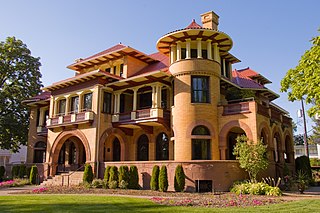
The Patsy Clark Mansion is a Spokane, Washington, United States, residence that was designed by architect Kirtland Cutter in 1897 for mining millionaire Patsy Clark. It is located at 2208 West Second Avenue in the city's historic Browne's Addition. The mansion had long been used as a restaurant. In 2002, a law firm purchased the mansion for $1.03 million in order to rescue the landmark from further deterioration. The mansion now houses a law firm, while still remaining open for private rentals for small events.

Coeur d'Alene's Old Mission State Park is heritage-oriented in the western United States in northern Idaho, preserving the Mission of the Sacred Heart, or Cataldo Mission, a national historic landmark. The park contains the church itself, the parish house, and the surrounding property. Built in 1850–1853, Mission of the Sacred Heart is the oldest standing building in Idaho.[1] It was designated a National Historic Landmark in 1961,[2] and put on the National Register of Historic Places in 1966.[3]
John Gray House may refer to:
The Hotel Charbonneau is located at 88 Wisconsin Street in Priest River, Idaho and is listed on the National Register of Historic Places. It was originally constructed in 1912 by Charles and Dora Charbonneau. During the first half of the 20th century, Priest River and the Hotel Charbonneau, which is located one block away from where the train station used to be, was a popular stopping-off point for people traveling to nearby Spokane, Coeur d'Alene, Sandpoint, and Priest Lake. In 1920, Dora Charbonneau added a brick addition onto the south side of the hotel to accommodate more guests. After the brick addition was built, the Hotel Charbonneau boasted 27 guest rooms with more than half of them having their own private bathrooms; an extravagant luxury at that time.

The Coeur d'Alene Masonic Temple in Coeur d'Alene, Idaho is a building constructed during 1909–1911. It was listed on the National Register of Historic Places in 1978.
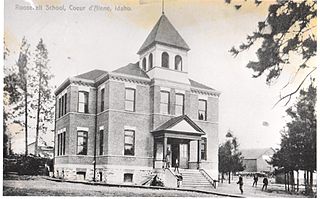
The Roosevelt Inn is located near downtown Coeur d'Alene in North Idaho. Originally built in 1905 as the Roosevelt School, it is recognized as a historic building listed on the National Register of Historic Places. It was converted into an inn in 1994.
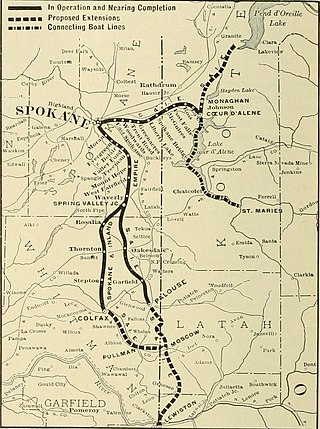
The Spokane and Inland Empire Railroad Company (S.&I.E.R.R.Co.) was an electrified interurban railway operating in Spokane, Washington and vicinity, extending into northern and central Idaho. The system originated in several predecessor roads beginning c. 1890, incorporated in 1904, and ran under its own name to 1929. It merged into the Great Northern Railway and later, the Burlington Northern Railroad, which operated some roads into the 1980s.

George Williams was an American architect based in Coeur d'Alene, Idaho. He was born in Illinois and moved to Coeur D'Alene in 1903.

First United Methodist Church is a historic Methodist church at 618 Wallace Avenue in Coeur d'Alene, Idaho. It was built in 1906 and was added to the National Register in 1979.

The Coeur d'Alene Federal Building is a historic building built in 1927 in Coeur d'Alene, Idaho. It was listed on the National Register of Historic Places in 1977.
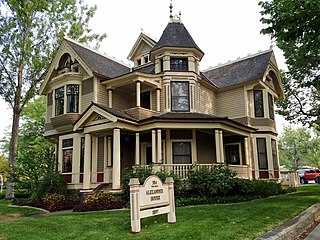
The Alexander House is a Queen Anne style house built in Boise, Idaho, in 1897. The house was constructed for Moses Alexander the year he became mayor of Boise. Alexander later became governor of Idaho.

The Coeur d'Alene City Hall is a historic building in Coeur d'Alene, Idaho. It was built in 1908, and designed in the Renaissance Revival style by architect George Williams. It served as the de facto courthouse until the construction of the Kootenai County Courthouse in 1926, and it later housed the offices of city officials, police officers and firefighters. It has been listed on the National Register of Historic Places since August 3, 1979.

The Clark House is a historic house in Clarksville, Idaho. It was built in 1912 as a summer residence for F. Lewis Clark, a mining millionaire who disappeared in Santa Barbara in 1914 and was believed to have committed suicide. Clark's servants lived in the wings. The house was designed in the American colonial style and has been attributed to architect Kirtland Cutter; however, blueprints discovered in Boise, ID show that the actual architect was George Canning Wales of Boston. It has been listed on the National Register of Historic Places since December 12, 1978.

The John A. Finch Caretaker's House is a historic house in Hayden Lake, Idaho. It was built in 1903 for John A. Finch, a significant investor in Coeur d'Alene's mines. It was designed in the Swiss Chalet style by architect Kirtland Cutter. It has been listed on the National Register of Historic Places since September 14, 1987.

St. Thomas Catholic Church is parish of the Roman Catholic Church in Coeur d'Alene, Idaho. Founded in 1890 to serve the Catholic miners and lumber workers relocating to the area, it remains an active congregation of the Diocese of Boise.

John Aylard Finch was an affluent English immigrant, businessman and philanthropist in the Inland Northwest region of the United States.
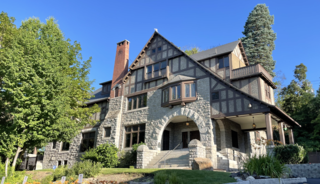
The Glover Mansion is a historic Tudor revival home built in 1888 and located in the Cliff/Cannon neighborhood of Spokane, Washington, just uphill from and overlooking the city's downtown. The home was designed by architect Kirtland Cutter for James N. Glover, who founded the city of Spokane in 1873. Over the years the Glover Mansion has served as a residence, housed Spokane's Unitarian Universalist Church, and more recently been used as an event venue.

















